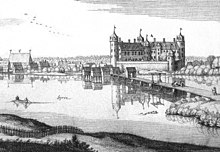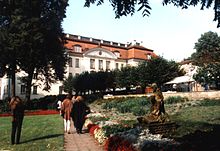Castle Island (Köpenick)
| Castle Island | ||
|---|---|---|
| Waters | Dahme | |
| Geographical location | 52 ° 26 '34 " N , 13 ° 34' 22" E | |
|
|
||
| length | 230 m | |
| width | 110 m | |
| surface | 3 ha | |
| Residents | uninhabited | |
| Location sketch | ||
The Köpenicker Schlossinsel is an island in the Dahme shortly before its confluence with the Spree in the Berlin district of Köpenick . It has an area of around 6 hectares.
The island includes today's Köpenicker Castle and its park. A bridge connects it with the island of Köpenick's old town to the north, on which the town of Köpenick developed under the protection of the castle, together with a Slavic fishing settlement ( vicus Kytz ) on the east bank of the Dahmebucht, first mentioned in the Landbuch of the Mark Brandenburg in the 13th century which served the lords of the castle as a settlement for the servants. The name Frauentog (for women's train) of the stretch of water between Schlossinsel and Kietz refers to an old legend according to which fisher women made a rich fish haul there in the distress of the Thirty Years' War .
In the immediate vicinity of the northwestern end of the island is the Lange Brücke , which, as the Dahme-Überweg, connects the old town of Köpenick as well as the castle island and the castle with the newer districts to the west and northwest and the city center of Berlin.
Slavic, Wettin and Ascanian possessions
Its favorable location on the waterway made the island a populated place at an early stage, as finds from the Neolithic Age show. The Slavic tribe of the Sprewanen , who gave the city its name with Copnic ( island place ), fortified the island with a castle . In the middle of the 12th century the main castle and the center of power of the tribe were located here under their prince Jaxa von Köpenick , who is probably identical to Jaxa, who was defeated by the Ascanian Albrecht the Bear in 1157 in a decisive battle near Brandenburg an der Havel . The year 1157 is considered to be the birth of the Mark Brandenburg , which, however, did not include Köpenick. Jaxa could, insofar as it was actually the same person, retreat to the Köpenicker Castle.
Allegedly the Wettins conquered the castle as early as 1178, according to another account they had owned Köpenick only since 1209. The events that led to the withdrawal of Jaxa von Köpenick and any successors to Jaxas are unknown. It was first mentioned in documents under the name Copenic in 1209 . In 1239 the Ascanian margraves Johann I and Otto III were looking for . the decision about the possession of the Teltow and Barnim against the Wettin Margrave of Meissen, Heinrich the Illustrious and the Archbishop of Magdeburg, Wilbrand von Käfernburg with the sword. In this six-year Teltow War , the Askanians razed the castle in 1240, but had to withdraw again and in return accept the devastation of their properties in front of Strausberg by the Wettins. In 1245 the Ascanians had forced the decision for themselves. Since then, the castle island has belonged permanently to the Mark Brandenburg.
Electoral hunting lodge and palace gardens

The building enthusiast but financially poor Elector Joachim II of Brandenburg had a hunting lodge built in the Renaissance style in 1558 under the direction of Wilhelm Zacharias , which was then torn down again in 1688. Prince Friedrich, heir to the throne of the incumbent Elector and later Friedrich III. , initiated the construction of today 's Köpenick Palace in 1688 . For this purpose he won the Dutch painter and builder Rutger von Langerfeld as an architect.
There are other buildings on the castle island, such as the baroque castle chapel , which was built between 1682 and 1685 according to designs by the master builder Johann Arnold Nering and is surrounded by low farm buildings . In addition to church services, concerts are also performed in the chapel. The beautiful palace park , created at the same time as the first development by filling, was originally a baroque garden , which, according to old views and plans , showed several broderie parterres on both sides of a central axis running south and was bordered by avenues on the riverside paths on the Dahme and the Frauentog to the east Dahm Bay located on the island. The palace park was changed again and again with the new buildings and renovations. The last time there was a comprehensive change in 1963/64, an open-air stage and an open-air restaurant were added, and a castle café was opened in a historic building. Two rows of linden trees were freshly planted and a low wall now separates the built-up area from the palace gardens.
Excavations
The first excavations were carried out on the castle island between 1955 and 1958, and extensive archaeological excavations were carried out during the last renovations of the castle (approx. 1998 to 2003), whereby the remains of all previous buildings were uncovered. Interested visitors were able to take a look.
literature
- Michael Hofmann: The Köpenicker Castle Island . In: Guide to archaeological monuments in Germany . Volume 23. Berlin and the surrounding area. Theiss, Stuttgart 1991.
- Institute for Monument Preservation (Ed.): The architectural and art monuments of the GDR. Capital Berlin II . Henschelverlag, Berlin 1987
- Uwe Michas: The conquest and settlement of northeast Brandenburg. In the series: Discoveries along the Märkische Eiszeitstraße , Volume 7. Society for the research and promotion of the Märkische Eiszeitstraße (Ed.), Eberswalde 2003, ISSN 0340-3718 .
- Winfried Schich : The medieval Berlin (1237-1411) . In: Wolfgang Ribbe (Ed.), Publication of the Historical Commission in Berlin: History of Berlin . 1st volume, CH Beck, Munich 1987, ISBN 3-406-31591-7 .
- Joachim Schulz, Werner Gräbner: Architectural Guide GDR. BERLIN . 2nd improved edition, VEB Verlag für Bauwesen, Berlin 1976
Web links
- Entries in the Berlin State Monument List
References and comments
- ↑ Legend about the Köpenicker Frauentog
- ↑ Although it is common historiography, it is not certain whether Jaxa, who fought with Albrecht the Bear in 1157, and Jaxa von Köpenick were the same person. See Jaxa von Köpenick .
- ^ Marca Brandenburgensis
- ↑ Winfried Schich: The medieval Berlin ... , p. 155




